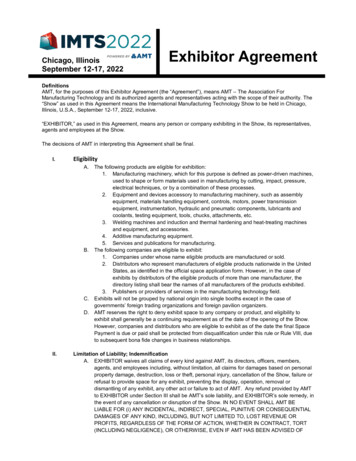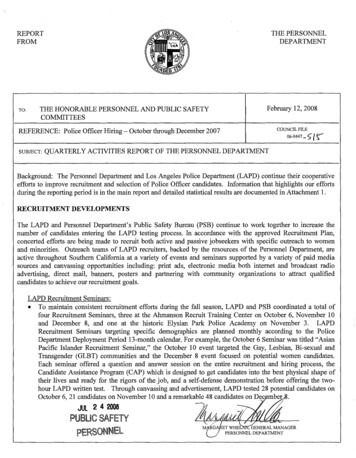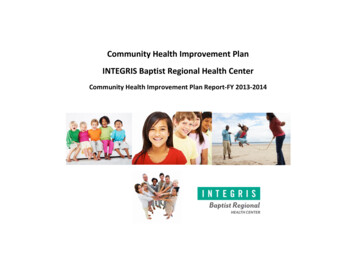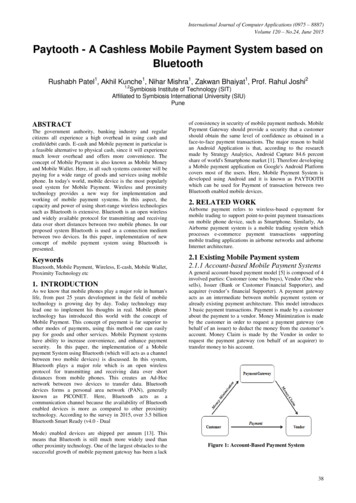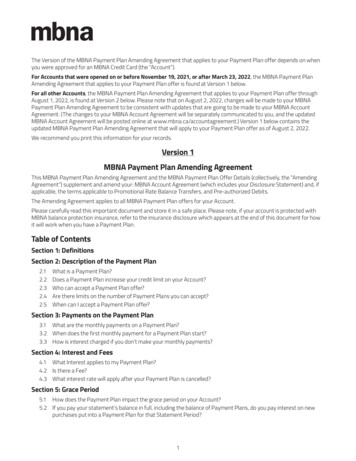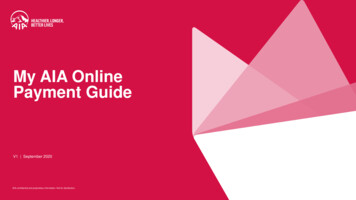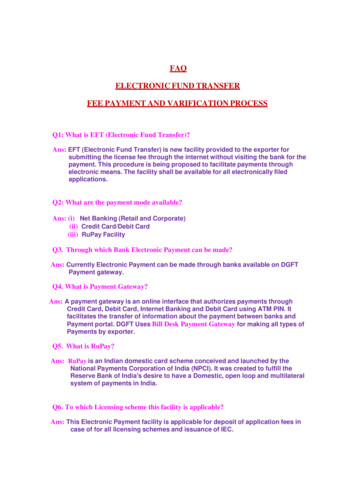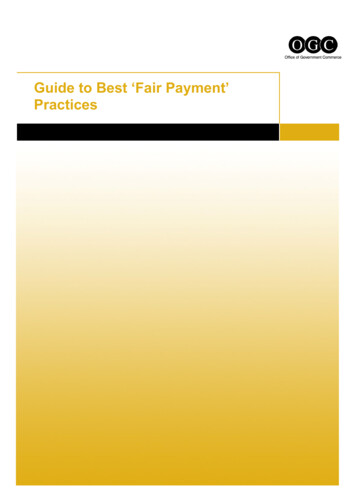
Transcription
Guide to Best ‘Fair Payment’Practices
2Introduction3Definition of “Fair Payment”3The case for change3Principles and characteristics of an exemplary “Fair Payment” process4Putting these principles into practice5Model “Fair Payment” Charter6Performance Monitoring9Cost of Implementation10Summary of recommendations10Annexes12ANNEX A: BUSINESS CASE FOR “FAIR PAYMENT”13ANNEX B: CASE STUDY - M42 ATM PROJECT23ANNEX C: PROJECT BANK ACCOUNTS – A CLIENT’S GUIDE27APPENDIX A: ILLUSTRATIVE TRUST DEED36APPENDIX B: STANDARD TRAINING AGENDA48APPENDIX C: TYPICAL PAYMENT PROCESS49ACKNOWLEDGEMENTS50
3Introduction1.Poor payment practices in the construction industry give rise to substantial additionalfinancing and transaction costs. More importantly certainty over how much and whenpayment is made builds trust between supply team members and underpinscollaborative working to achieve value for money projects for clients.2.This document recommends best “fair payment” principles and practices for adoptionin the public sector. These have been endorsed by the Public Sector ConstructionClients’ Forum (PSCCF).Definition of “Fair Payment”3.Payment is remuneration for work or services properly carried out. “Fair payment” isconcerned with whether the contractual terms relating to the discharge of thepayment obligation and the payment process are fair and adhered to. The processand payment periods should minimise transaction costs and financing chargesacross projects.The case for change4.Fair payment issues arise from commercial pressures, “custom and practice”, lack ofindustry sophistication and maturity, as well as deliberate manipulation. Although theproblem is often characterised as being one between the lead contractor and subcontractors, issues can and do occur throughout the supply chain from clients payinglate, to material suppliers invoicing inefficiently.5.Extended payment periods and delayed payment do not just incur short-term financecosts. Poor payers may experience higher tenders, with surcharges being imposedby both lead contractors and their supply chains that place a very high value on‘payment certainty’.6.The aim of the recommended improvements is to provide greater certainty onpayment to everyone in the supply chain and to optimise payment periods tominimise financing charges. As part of a consultancy study for the working group,typical existing payment regimes were mapped against a best practice process.Based on analysis (see Annex A) corroborated by interviews with contractors andthe supply chain, public sector clients could expect to save up to 2.5% onconstruction costs from the introduction of better payment processes. These savingscould rise over time if the supply chain were able to reduce overheads relating todebt chasing and administration. The additional knock-on benefits of greaterproductivity and a reduction in construction disputes are difficult to quantify but theyare likely to be substantial.7.It is estimated that widespread adoption of the principles and fair payment practicesset out in this guide would save the public sector some 200M rising to over 750Mas the processes become embedded and the confidence in the system increases.
4Principles and characteristics of an exemplary“Fair Payment” process8.The PSCCF recommend that all public sector clients and their principal contractors(or supply chain members) should formally adopt principles similar to those below asthe basis for reviewing their procurement strategy and procedures with regard topayment practices:a) Companies have the right to receive correct full payment as and when due.Deliberate late payment or unjustifiable withholding of payment is ethicallyunacceptable.b) “Fair payment” should apply equally between the client and lead contractor andthroughout the supply chain.c) The process should be transparent; for example companies in the supply chainshould have access to information on the certification procedures, paymentprocedures and payment times, issued on the clients’ behalf, relevant to theirwork packages, in order that they have certainty of how much and when they willbe paid.d) The correct payment should represent the work properly carried out, or productssupplied, in accordance with the contract. Any withholding of payment due todefects or non-delivery should be proportionate and justified.e) Contractual payment times should be designed to optimise finance chargesacross the whole supply chain recognising the lower financing charges onGovernment borrowing compared to the high short-term marginal rates availableto small businesses.f) The process needs to be practicable and efficient for all participants, reducingunnecessary transaction costs and without the need for additional regulatory andauditing activities.g) A range of tools and models is applicable depending on the nature of the client’swork (e.g. occasional clients vs. multi-project programmes), the project size andthe different levels of sophistication of companies in the construction sector.h) The process should seek to provide protection to the client and all supply chainmembers in event of a company becoming insolvent.i) The process should be seen as part of a wider agenda to achieve bettercollaborative working, thereby decreasing disputes and providing a good value formoney project outturn.
5Putting these principles into practice9.Dealing with payment issues is part of the wider agenda by the PSCCF to improvecooperation and communication in the construction industry. Early engagement ofextended supply chains allows projects to benefit from the specialist knowledge andskills of the whole supply chain. Integrated team working is essential to this processand needs to be supported by fair and transparent payment processes andappropriate supporting mechanisms or tools.“Fair Payment” Charter10.To underpin the change, it is recommended that there should be a “Fair Payment”Charter, based on the model set out below, which would be agreed and signed bythe client and the main supply chain members working on a project or a frameworkof projects.
6Model “Fair Payment” CharterModel “Fair Payment” Charter1Fair and transparent payment practices are an essential underpinning to achievingsuccessful integrated working on construction projects. In working with each other ingood faith and in a spirit of mutual trust and respect, we agree that by 1st January 20082we will meet the “Fair Payment” commitments set out below: Companies have the right to receive correct full payment as and when due.Deliberate late payment or unjustifiable withholding of payment is ethically notacceptable. “Fair payment” will apply equally between the client and lead contractor andthroughout the supply chain3. The process will be transparent in order that members of the supply chain havecertainty of how much and when they will be paid. Companies will consider, where appropriate, operating relevant contracts on an openbook basis. The correct payment will represent the work properly carried out, or products supplied,in accordance with the contract. Any client arrangements for retention will bereplicated on the same contract terms throughout the supply chain. Any withholding ofpayment due to defects or non-delivery will be proportionate and demonstrablyjustified in line with arrangements made at the time of contract. To ensure effective and equitable cashflow for all those involved, all contracts willprovide for regular payments and have payment periods not exceeding 30 days. In order to avoid payment delays, the client and all supply chain members will agreepayment procedures at the outset of their contracts. Payment will be throughelectronic BACS transfer and will apply throughout the supply chain. Monitoring and auditing and problem resolution procedures will be agreed betweenthe parties.We the undersigned agree that this Charter is not intended to be a legally bindingdocument and not used in construing any contractual commitment.1 The Charter sets out the values and arrangements relating to payment practicesconsistent with integrated working. The Model Charter is flexible to allow for adaptationand can either be a standalone document or part of a wider partnership charter. Ineither case it is not intended to be legally binding.2 An introduction period is to allow time for clients and contractors to modify theirbusiness systems and procedures.3 The client would sign The Charter at the outset. Contractors and supplierssubsequently engaged would be expected to sign the Charter before appointment.
7Best practice fair payment process11.Achieving fair and efficient payment to all parties requires a significant timecommitment at the outset of contracts to agree and harmonise payment proceduresand cycle in order to achieve the commitments in the Charter such as the maximum30-day payment period. The chart below illustrates an example payment cycle forclient, lead contractor and the 1st and 2nd tier supply chain.Example Payment Cycle-5Lead ContractorS/C prepare applicationsLead Contractor assembles applicationQS certificationArch certificationClient payment period1 & 2nd tier Supply ChainS/C prepare applicationsLead Contractor checks applicationsPayment to Supply Chain5ValuationDateCalendar Days -10101520253035404550Contractor paid 21 days aftervaluation date (assuming 14 dayClient payment and 7 days forBOTH QS Valuation andCertification).7 daysSupply Chain payments within30 days from valuation date.12.Use of BACS transfer is widespread in the sector and it is recommended that itshould be the normal form of payment throughout the supply chain (see Model “FairPayment” Charter).13.Public sector clients may wish to consider more frequent interim measures, shorterguaranteed payment periods and advanced certification4 or equivalent in caseswhen contractors and suppliers are able to offer substantial discounts (clients havereported discounts of up to 10% in some cases).Contractor relationships and selection14.Evidence of good and current performance on “fair payment” should be a key prequalifying criterion for selection of lead contractors and through the “Fair Payment”Charter or contractual arrangements to further tiers of the supply chain.15.The benefits of early involvement of specialist contractors and suppliers in thedesign and planning stage, where appropriate paying for their time on a fee basis,are now generally recognised through such approaches as two-stage contractingand multi-contract supply arrangements. During the planning stage, opportunitiesarise to reduce inefficiencies in the payment processes and gain benefit from greatercash flow certainty. For example, clients may wish to consider paying (but notnecessarily employing) major sub-contractors and suppliers directly uponauthorisation from the lead contractor that the work has been properly carried out.4See case study in Annex B on the Highways Agency M42 ATM project
8Simplification of interim measurement16.Payment delays and additional costs arise through traditional measurement andcertification systems. It is recommended that there should be greater use of welldefined milestone payments and payment schedules to simplify the process. Thiswould lead to greater certainty of payment, lower financing charges and reducedtransaction costs. Variations would be dealt with separately.Retentions17.Unfair withholding of retentions has an adverse impact on cashflow and isdetrimental to relationships on site. Public sector clients are recommended tomonitor the implementation of the proposed Charter commitments on fair contractterms and fair withholding of payment. Collaborative working and industrycommitment to and delivery of improved quality should obviate the need forretentions over time.Project Bank Accounts18.There is very good alignment between the mechanism of Project Bank Accounts5(PBA) and the principles of fair payment, and it is recommended that public sectorclients should progressively specify use of Project Bank accounts where practicableand cost effective. Where they are used, clients should give a written commitment toa payment period linked to a PBA. Their use generates the confidence in both thesupply chain and the lead contractor, reducing their risks and prices by providing realsurety of cash flow for all parties. A good practice process as shown in the examplebelow would reduce the payment cycle by at least 18 days compared to currentarrangements:Example using Project Bank Account1 & 2nd tier Supply ChainS/C prepare applicationsLead Contractor checks applicationsPayment to Supply Chain551015202530354045DateLead ContractorS/C prepare applicationsLead Contractor assembles applicationQS certificationContract Administrator certificationClient payment period to PBAPayment from PBA-5ValuationCalendar Days -10Assumed 14 days would be optimumSupply Chain payment at same time as Main ContractorProject Bank Accounts are commended in the NAO Report “Improving Public Servicesthrough better construction” and are included in the 2012 Construction Commitments.50
919.A guide for their use is attached (see Annex C). Initially it is expected that clients willspecify their use on larger open book projects but as confidence in their operationbuilds this can be extended more widely and to other forms of projects. To supporttheir introduction, an illustrative trust deed has been included in Appendix A basedon discussions with major banks.20.On PBAs, interim payments are agreed in the normal way including an analysis ofthe payments to each member of the project supply chain (down to a pre-agreedlevel), which is then forwarded to the bankers operating the PBA. The client depositsmoney directly into the PBA, which then distributes it, by BACS, to the contractor andsupply chain in accordance with the breakdown analysis.21.PBAs have a number of benefits including transparent management of cash flow, areduction of financing charges across the supply chain, less opportunity for paymentabuse and reduced impact of insolvency of a supply chain member. The time upfrontin setting up the PBA reinforces integrated working.Performance Monitoring22.Clients should monitor their own and the supply chain’s compliance with the FairPayment Charter (FPC). Compliance with the Charter should be a significant factorin the future selection of project teams and incentives or rewards under frameworkagreements e.g. increased workload. For larger projects compliance with the FPCshould be checked as part of the OGC Gateway Review process6 (Gateway 5).23.Any national measurement of performance on payment practices needs to balancethe costs/benefits of such a system against the reliability of the data. OGC intendcollecting data on payment performance through an annual survey of CentralGovernment clients and the supply chain (through the main construction umbrellabodies). Three questions are proposed: What % (by value) of Central Government construction projects7 do not have asigned “Fair Payment” Charter in place? What % (by value) of Central Government contract interim payments are notpaid/received within 30 days? What is the value of projects7 ( M) for which a Project Bank Account is in place?24.A baseline survey is planned for the autumn of 2007 and annually thereafter withresults being reported to the PSCCF.25.OGC plans an overall review of the progress on implementation of the Fair PaymentCharter and these recommendations two years after full implementation (i.e. inJanuary 2010).6See description at OGC - OGC Gateway Review for Programmes & Projects7Started during the current financial year
10Cost of Implementation26.The thrust of these recommendations is to standardise and simplify paymentprocesses based on current best practice. There will be start up and training costsfor implementation of Project Bank Accounts, which will vary in accordance withproject size and complexity. Costs of implementation are expected to be between 5,000 and 10,000 (i.e. less than 0.1% of a typical project). Much of this cost isone-off and does not need to be expended in full follow-on contracts. Bank chargesfor project bank accounts are likely to be modest and for larger projects more thanoffset by interest generated while interim payments are on deposit.Summary of recommendations27.The following is a summary of the recommended best “fair payment” principles andpractices for adoption in the public sector as endorsed by the PSCCF:Recommendations1Formally adopt principles of “fair payment”(Para 8)2Require “Fair Payment” Charters to be signed forcontracts/frameworks (Full implementation by 1st January 2008).(Para 10)3Introduce best practice payment processes targeted at achievingpayments to the supply chain within 30 days.(Para 11)4Consider more frequent interim measures, shorter guaranteedpayment periods and advanced certification (not payment) in caseswhen contractors and suppliers are able to offer substantial discounts.(Para 13)5Use evidence of good and current performance on “fair payment” as akey pre-qualifying criterion for selection of lead contractors.(Para 14)6Consider paying (but not necessarily employing) major sub-contractorsand suppliers directly.(Para 15)7Make greater use of milestone payments and payment schedules tosimplify the interim measurement process.(Para 16)8Monitor Charter commitments regarding fair contract terms and fairwithholding of payment.(Para 17)9Progressively specify use of Project Bank accounts where practicableand cost effective.(Para 18)10Monitor compliance with the “Fair Payment” Charter.(Para 22)
11Mapping of recommendations to “Fair Payment” principlesThe table below shows how each recommendation maps to the agreed principles.(Tick (D) indicates which practice closely corresponds with each principle)2.“FairPayment”ChartersDDD3.Best ment8.RetentionsD9.Project BankAccountsD10.FPCcomplianceDDDDICollaborative workingHInsolvency protectionGAppropriatenessFEfficiencyEOptimised paymentDPayment completenessCTransparent processBApplies to allRecommendations:ARight to fair paymentPrinciples:DDDDDDDDDDDDDDDDDDDDD
12AnnexesAnnex ABusiness Case for “Fair Payment”Annex BCase Study: M42 ATM ProjectAnnex CProject Bank Accounts – A Client’s Guide
ANNEX A13ANNEX A: BUSINESS CASE8 FOR “FAIR PAYMENT”Introduction28.Fair payment issues arise from commercial pressures, “custom and practice”, lack ofsophistication and maturity, as well as deliberate manipulation. Although the problemis often characterised as being one between the lead contractor and sub-contractors,issues occur throughout the supply chain from clients paying late to sub-contractorsnot invoicing for the work they have carried out.29.This Annex seeks to quantify the benefits of adopting a fairer and more efficientpayment process. It is based on an analysis of typical contracts supported byinterviews9 and surveys10 with supply chain members.8Abridged version of consultancy study by Bucknall Austin.9In-depth interviews were held with senior management personnel (generallyMD/FD/Commercial Directors) in a cross section of contractors, sub-contractors, suppliersand consultants. These interviews enabled detailed discussions to be undertaken toascertain their experience of both good and poor payment, examine reasons for instancesof poor payments and explore identify risks and concerns and identify views of all partieson the benefits of adopting fairer and more efficient payment processes.10This Annex also draws on the results of surveys of their membership undertaken by theSpecialist Engineering Contractors’ Group (SECG) and the Association for Consultancy &Engineering (ACE).
ANNEX A14Existing situation30.The following figure shows the payment cycle for a typical traditional contract basedon JCT98 suite of contracts. This is considered as the base case in this businesscase analysis.Typical Traditional Payment Cycle (base case)Lead ContractorS/C prepare applicationsLead Contractor assembles applicationQS certification (allowed up to 7 days)Arch. certification (allowed up to 7 days)Client payment period1 & 2nd tier Supply ChainS/C prepare applicationsLead Contractor checks applicationsPayment to Supply Chain-55ValuationDateCalendar Days -10101520253035404550Contractor paid 35 days aftervaluation (assuming 21 dayClient payment and 7 days eachfor QS Valuation andCertification).Typically 14,21 or 28 days as amended in contract (21 assumed)7 daysIf Contractor payments linked to being paid byClient then supply chain would not be paid 42days after the valuation date (28 days afterCertification) at best.31.Allowing the normal contractual times for certification by the quantity surveyor andarchitect and assuming a 21 day client payment period experience suggests that themain contractor will often not get paid until 35 days after the valuation date.32.Although the Construction Act prohibits “pay when paid” clauses, in practice manysub-contractors carry out work before formal contracts are in place and, in any case,lead contractors will wish to provide for contractual arrangements such that theyhave a reasonable expectation of being paid by the client before he pays his supplychain. This means that sub-contractors and suppliers are not paid until 42 days afterthe valuation date at best.33.In practice, wrongly presented applications, inefficient administration, mismatchesbetween systems usually greatly increase this period. Some lead contractors’business models generally also assume retention of cash for a period to enhanceprofitability. The lead contractor will of course incur costs from his own in-houseresources, labour-only sub-contracts and some suppliers before he receivespayment.34.Extended payment periods and delaying payments does not just incur short-termfinance costs. Poor payers will experience higher tenders, with surcharges beingimposed by both contractors and their supply chains that value ‘payment certainty’above all.35.Virtually all those interviewed, during the consultancy study, had first handexperience of payment delays – up to 90 days. 60-day payments from clients werecommon. Supply chain respondents stated that the ‘delays in lead contractorsreceiving monies from client’ was the most common cause of delays in payments tothem and accounted for more than 20% of payment delays. Most of those
ANNEX A15interviewed also dealt with this by either refusing to work with the client or imposing asurcharge on any tender.36.Where surcharges were allowed, they were significantly more than short-termfinancing costs. For example, one contractor included a standard uplift factor of 5%for poor payments for bids where 60 day payment terms were the norm, despitefinance costs for the delay equating to approximately 1%. In other cases, someclients report that they have been able to negotiate 5% to 10% discounts with theirsuppliers and sub-contractors where they have been able to guarantee a reliableand speedy cashflow.37.The ACE survey found that payment delays were less frequent in public sector thanprivate sector. Within the public sector, 25% of members had witnessed delays inmore than 25% of projects, in the private sector, this increased to nearly 40% ofmembers.Options for improving the payment process38.The aim of any improvements is to provide greater certainty on payment to everyonein the supply chain and to optimise the payment process to minimise financing andtransaction charges. Two options are considered: (A) “Fair Payment” Charter linkedto improved “fair payment” process and (B) Use of Project Bank Accounts.
ANNEX A16Option A: “Fair Payment” Charter linked to improved fair payment processUnder this option, clients, lead contractors and their supply chains would committhemselves to a “Fair Payment” Charter. This would include greater transparency,equitable retention arrangements, more efficient payment procedures and paymentperiods not exceeding 30 days. An example of such a process between client, leadcontractor and the 1st and 2nd tier supply chain is shown below:Example Payment CycleLead ContractorS/C prepare applicationsLead Contractor assembles applicationQS certificationArch certificationClient payment period1 & 2nd tier Supply ChainS/C prepare applicationsLead Contractor checks applicationsPayment to Supply Chain40.-55ValuationCalendar Days -10Date39.101520253035404550Contractor paid 21 days aftervaluation date (assuming 14day Client payment and 7 daysfor BOTH QS Valuation andCertification).7daysBest Practicetraditionally achievesSupply ChainPayment in 28 daysfrom valuation date.14 days improvement compared to base caseIn this option, the lead contractor would be paid 21 days after the valuation date(allowing 7 days for certification and 14 days for client payment) with the supplychain getting payment 28 days after the valuation date. This is a 14 dayimprovement compared to the typical traditional payment cycle (base case).
ANNEX A17Option B: Use of Project Bank accounts41.Under this option, in addition to the Fair Payment Charter, clients would give awritten commitment to a payment period linked to a Project Bank Account. Thiswould generate the confidence in both supply chain and the contractor to reducerisks and prices by providing real surety of cash flow for all parties. A typical ProjectBank Account process is shown below:Using Project Bank AccountLead ContractorS/C prepare applicationsLead Contractor assembles applicationQS certificationContract Administrator certificationClient payment period to PBAPayment from PBA1 & 2nd tier Supply ChainS/C prepare applicationsLead Contractor checks applicationsPayment to Supply Chain-55101520253035404550ValuationDateCalendar Days -10Asumed 14 days would be optimumSupply Chain payment at same time as Main Contractor18 days improvement compared to base case42.A good practice process would provide surety of payment and a reduction of thepayment cycle by 18 days compared to the typical traditional payment cycle (basecase).
ANNEX A18Benefit Analysis43.The analysis was based on a typical 10M 52 week project with 16 sub contracts,which have been averaged at 0.5M each and identified the following averagesavings compared to the base case:Savings compared to base case:Option A:Option B:Improved “FairPayment” ProcessUsing Project BankAccount11Reduction for Cash Collection-0.1%-0.1%Reduction for Cash Flow Risk Certainty-0.8%-2.1%Reduction for Trade IndemnityInsurance0%.-0.2%Reduction for Cash Collection-0.1%-0.2%Reduction for Cash Flow Risk Certainty-0.5%-0.8%Increased Profit to offset loss of cashflow benefit 0.5% 1%Total Impact on Project-1%-2.5%Sub-contract (total of all sub-contracts)Lead Contract11Project Bank Account option based on average of cases with client payment periods of14 and 21 days.
ANNEX A1944.The above savings assume no change to the payment dates for the sub-subcontractors; however, in practice the adoption of earlier payments will also lead toearlier payments by sub-contractors to their principal suppliers and sub-contractorswho may see further benefits.45.These overall savings were corroborated by the surveys and interviews. There was astrong consensus in the answers to the question “How much would your tenderreduce if a Government Approved Project Bank Account Process is put in place”.Over 90% of contractors and supply chain answered that this would save between0% to 5%. The final benefit will depend on how well the contractors are currentlytreating their supply chains; those that already adopt best practice payment termswill realise lower savings. The average saving and the most frequently quoted figurewas an overall saving on the project of 2.5%.46.Although accounting methods and overhead structures vary substantially betweencompanies, this saving was attributed to two main elements with payment suretybeing the single most important issue quoted by the majority of those interviewed: Finance Charges – approximately 0.5% Surety of Cash flow – approximately 2%47.Respondents felt that further longer term client savings would arise if the publicsector adopted fair payments and Project Bank Accounts universally, as they wouldbe able to reduce their overheads relating to debt chasing, financing and supplychain insolvency insurance.48.Although headline profit figure at tender may increase, few of the contractorsinterviewed believed that they would need to increase overall tender prices to coverloss of cash flow benefits that they currently have.49.Debt chasing and supply chain insolvency insurance were generally built intooverheads. The costs for these varied between companies but representedapproximately 0.5% of turnover. It will inevitably take time for contractors and supplychain to realise the full benefits of efficient payment regimes and reduce overheadallowances.Additional Benefits50.The use of best practice fair payment practices and Project Bank Accounts couldbecome a key part of collaborative projects and will help to improve trust andconfidence throughout the supply chain. As overall confidence in the systemincreases the incidence of claims due to poor payment should be substantiallyreduced.51.Improved payment terms will be a real incentive for new entrants from other sectors(e.g. good logistics organisations) who have steered clear of the construction sectorin the past because of its poor reputation for payment.Risks52.There are a number of key risks to be considered when implementing fair paymentstrategies:
ANNEX A20Client Risks:a) Failure to achieve payment periods – The key to realising reduced overalltender costs is confidence in achieving payment certainty. If agreed paymentperiods are not achieved then reductions in direct and indirect costs will notbe fully realised. Clients need to ensure that their payment departments arecapable of achieving the pre-agreed payment periods consistently on eachand
Model "Fair Payment" Charter 6 Performance Monitoring 9 Cost of Implementation 10 Summary of recommendations 10 Annexes 12 ANNEX A: BUSINESS CASE FOR "FAIR PAYMENT" 13 ANNEX B: CASE STUDY - M42 ATM PROJECT 23 ANNEX C: PROJECT BANK ACCOUNTS - A CLIENT'S GUIDE 27 APPENDIX A: ILLUSTRATIVE TRUST DEED 36 APPENDIX B: STANDARD TRAINING AGENDA 48 APPENDIX C: TYPICAL PAYMENT PROCESS 49 .

